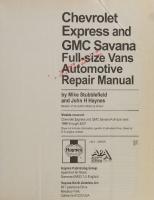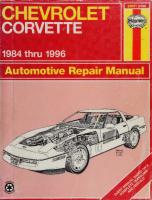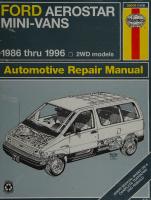Haynes Chevrolet Express and GMC Savana Full-Size Vans 1996 thru 2007 Automotive Repair Manual 1563927195, 9781563927195
“1 v. (various pagings) : 27 cm "Models covered, Chevrolet Express and GMC Savana full-size vans 1996 through 2007
131 62 34MB
English Pages 292 Year 2008
Recommend Papers

- Author / Uploaded
- Mike Stubblefield
- John H. Haynes
- Similar Topics
- Technique
- Transportation: Cars, motorcycles
File loading please wait...
Citation preview
Chevrolet ¢ GMC Full-size vans
|
1996 thru 2007
Haynes Repair Manual Based on a complete teardown and reb uild:
e
MYeLen eS
3 2233 00186 tM ||
Chevrolet Express and GMC Savana Full-size Vans Aitciniotive
> ‘Repair Manual by Mike Stubblefield and John H Haynes Member of the Guild of Motoring Writers
Models covered: Chevrolet Express and GMC Savana Full-size vans 1996 through 2007 Does not include information specific to all-wheel drive, diesel or
SAAS 8.1L models te ee EA
ES POM
(4L2 -24081)
REN SUP
stg KLMNO
PQ
A
J
ACTIVE
PARTS
A
A
Accessor Vee Haynes Publishing Group Sparkford Nr Yeovil Somerset BA22 7JJ England Haynes North America, Inc 861 Lawrence Drive Newbury Park California 91320 USA
Acknowledgements Technical writers who contributed to this project include John ’ Wegmann, Rob Maddox and Joe L. Hamilton. Wiring diagrams originated exclusively for Haynes North America, Inc. by Solution Builders.
© Haynes North America, Inc. 2005, 2008 With permission from J.H. Haynes & Co. Ltd.
A book in the Haynes Automotive Repair Manual Series Printed in the U.S.A. All rights reserved. No part of this book may be reproduced or transmitted in any form or by any means, electronic or mechanical, including photocopying, recording or by any information storage or retrieval system, without permission in writing from the copyright holder.
ISBN-13: 978-1-56392-719-5 ISBN-10: 1-56392-719-5 ‘Library of Congress Catalog Card Number 2008927725 While every attempt is made to ensure that the information in this manual is correct, no liability can be accepted by the authors or publishers for loss, damage or injury caused by any errors in, or omissions from, the information given. 08-288
ae
Contents Introductory pages About this manual Introduction to the Chevrolet Express and GMC Savana vans Vehicle identification numbers Buying parts Maintenance techniques, tools and working facilities Jacking and towing Booster battery (jump) starting Automotive chemicals and lubricants Conversion factors Fraction/decimal/millimeter equivalents Safety first! ; Troubleshooting
Chapter 1 Tune-up and routine maintenance
Chapter 2
1-1
PartA
4.3L V6 and 5.0L, 5.7L and 7.4L V8 engines
Chapter 2
0-5 0-5 0-6 0-7 0-8 0-14 0-15 0-16 0-17 0-18 0-19 0-20
2A-1
Part B
4.8L, 5.3L and 6.0L V8 engines
2B-1
Chapter 2 PartC General engine overhaul procedures
2C-1
Chapter 3 Cooling, heating and air conditioning systems
3-1
Chapter 4 Fuel and exhaust systems
4-1
Chapter 5 Engine electrical systems
5-1
Chapter 6 Emissions and engine control systems
6-1
Chapter 7 Automatic transmission
TA
Chapter 8 Driveline .
8-1
Chapter 9 Brakes
9-1
Chapter 10 Suspension and steering systems
10-1
Chapter 11 Body
11-1
Chapter 12 Chassis electrical system
12-1
Wiring diagrams
12-19
Index
IND-1
Haynes mechanic and photographer with a 1999 GMC Savana van
About this manual Its purpose
'
The purpose of this manual is to help you get the best value from your vehicle. It can do so in several ways. It can help you decide what work must be done, even if you choose to have it done by a dealer service department or a repair shop; it provides information and procedures for routine maintenance and servicing; and it offers diagnostic and repair procedures to follow when trouble occurs. We hope you use the manual to tackle the work yourself. For many simpler jobs, doing it yourself may be quicker than arranging an appointment to get the vehicle into a shop and making the trips to leave it and pick it up. More importantly, a lot of money can be saved by avoiding the expense the shop must pass on to you to cover its labor and overhead
costs. An added benefit is the sense of satisfaction and accomplishment that you feel after doing the job yourself.
Using the manual The
manual
is divided
into Chapters.
Each Chapter is divided into numbered Sections, which are headed in bold type between horizontal lines. Each Section consists of consecutively numbered paragraphs. At the beginning of each numbered Section you will be referred to any illustrations which apply to the procedures in that Section. The reference numbers used in illustration captions pinpoint the pertinent Section and the Step within that Section. That is, illustration 3.2 means the illustration refers to Sec-
tion 3 and Step (or paragraph) 2 within that Section. Procedures, once described in the text, are not normally repeated. When it’s necessary to refer to another Chapter, the reference will be given as Chapter and Section number. Cross references given without use of the word “Chapter” apply to Sections and/or paragraphs in the same Chapter. For example, “see Section 8” means in the same Chapter. References to the left or right side of the vehicle assume you are sitting in the driver’s seat, facing forward. Even though we have prepared this manual with extreme care, neither the publisher nor the author can accept responsibility for any errors in, or omissions from, the information given.
NOTE A Note provides information necessary to properly complete a procedure or information which will make the procedure easier to understand.
CAUTION A Caution provides a special procedure or special steps which must be taken while completing the procedure where the Caution is found. Not heeding a Caution can result in damage to the assembly being worked on.
WARNING A Warning provides a special procedure or special steps which must be taken while completing the procedure where the Warning is found. Not heeding a Warning can result in personal injury.
Introduction to the Chevrolet Express and GMC Savana vans The Chevrolet and GMC full-size vans covered by this manual are conventional front engine/rear wheel drive layout. Fuel-injected V6 and V8 engines are used for power. The engine transmits power to the rear wheels through a 4-speed automatic transmission and a driveshaft to the rear axle.
These
models
feature
independent
front suspension with coil springs and shock absorbers at the front. At the rear, a solid rear axle is supported by leaf springs and shock absorbers. The power-assisted steering is either rack-and-pinion or conventional recirculatingball type. The rack-and-pinion steering unit
is mounted on a crossmember in front of the engine and the conventional steering box is located on the left-side frame rail. All models have a power-assisted brake system with disc brakes at the front and either disc or drum brakes at the rear. Some models are equipped with an Anti-lock Braking System (ABS).
Vehicle identification numbers VIN year and engine codes
Modifications are a continuing and unpublicized process in vehicle manufacturing. Since spare parts manuals and lists are compiled on a numerical basis, the individual
vehicle numbers are essential to correctly identify the component required.
—
Vehicle Identification Number (VIN) This very important identification number is stamped on a plate attached to the left side of the dashboard just inside the windshield on the driver’s side of the vehicle (see illustration). The VIN also appears on the Vehicle Certificate of Title and Registration. It contains information such as where and when the vehicle was manufactured, the model year and the body style.
Two particularly important pieces of information located in the VIN are the model year and engine codes. Counting from the left, the engine code is the eighth digit and the model year code is the 10th digit. On the models covered by this manual the engine codes are:
We iercttesutetoa tire V Pda vevuaeatesn teens IMitecabet geseet secorks c: Aer eee tree eee Resa stueaphe ncaa UO iecestesncseiteuees oat ul Reus teutigecocteeetestec
4.3L 4.8L 5.0L 5.3L 5.7L 6.0L 7.4L
V6 V8 V8 V8 V8 V8 V8
Wi caseteseencersagrean te » Gre ere Mi Sheila Ramet oes Vi ee. Naa Le 2 Sissi Nese TR iy Be AT cgrete nent ade eect © Gaxted toate cgi eg eee G vases cate: anes reae hs snacaasus serecanesSees
1998 1999 2000 2001 2002 2003 2004 2005 2006 2007
Equipment identification plate
On the models covered by this manual the model year codes are:
This plate is located on the inside of the hood. It contains valuable information concerning the production of the vehicle as well as information on all production or special equipment.
\ The VIN plate is visible from outside of the vehicle, through the driver’s side of the windshield
The Vehicle Safety Certification label is affixed to the end of the driver’s door
0-7
Vehicle identification numbers
On V6 and most V8 engines the identification number is located on a pad at the left rear of the engine
Typical automatic transmission identification number locations
Safety Certification label
Engine identification number
Transmission identification
The Safety Certification label is affixed to the left front door (see illustration). The plate contains the name of the manufacturer, the month and year of production, the Gross Vehicle Weight Rating (GVWR) and the safety certification statement. This label also contains the paint code. It is especially useful for matching the color and type of paint during repair work.
The Engine Identification Number on all engines except the 7.4L V8 is stamped into the rear of the engine block on the left side, near the transmission bellhousing (see illustration). On the 7.4L V8 engine it's located on a machined pad at the front of the engine block, below the right cyllinder head.
number The ID number on automatic transmissions is stamped into the transmission case above the oil pan flange (see illustration).
Buying parts \
Replacement parts are available from many sources, which generally fall into one of two categories - authorized dealer parts departments and independent retail auto parts stores. Our advice concerning these parts is as follows: Retail auto parts stores: Good auto parts stores will stock frequently needed components which wear out relatively fast, such as clutch components, exhaust systems, brake parts, tune-up parts, etc. These stores often supply new or reconditioned parts on
an exchange basis, which can save a considerable amount of money. Discount auto parts stores are often very good places to buy materials and parts needed for general vehicle maintenance such as oil, grease, filters, spark plugs, belts, touch-up paint, bulbs, etc. They also usually sell tools and general accessories, have convenient hours, charge lower prices and can often be found not far from home. Authorized dealer parts department: This is the best source for parts which are
unique to the vehicle and not generally available elsewhere (such as major engine parts, transmission parts, trim pieces, etc.). Warranty information: \|f the vehicle
is still covered under warranty, be sure that any replacement parts purchased regardless of the source - do not invalidate the warranty! To be sure of obtaining the correct parts, have engine and chassis numbers available and, if possible, take the old parts along for positive identification.
0-8
Maintenance techniques, tools and working facilities Maintenance techniques ' There are a number of techniques involved in maintenance and repair that will be referred to throughout this manual. Application of these techniques will enable the home mechanic to be more efficient, better organized and capable of performing the various tasks properly, which will ensure that the repair job is thorough and complete.
Fasteners Fasteners
are
nuts,
bolts, studs
and
screws used to hold two or more parts together. There are a few things to keep in mind when working with fasteners. Almost all
of them use a locking device of some type, either a lockwasher, locknut, locking tab
or thread adhesive. All threaded fasteners
let it work for a few minutes before trying to loosen the nut or bolt. Badly rusted fasteners may have to be chiseled or sawed off or
be clean and straight, with undam-
removed with a special nut breaker, available
aged threads and undamaged corners on the hex head where the wrench fits. Develop the habit of replacing all damaged nuts and bolts with new ones. Special locknuts with nylon or fiber inserts can only be used once. If they are removed, they lose their locking ability and must be replaced with new ones. Rusted nuts and bolts should be treated with a penetrating fluid to ease removal and prevent breakage. Some mechanics use turpentine in a spout-type oil can, which works quite well. After applying the rust penetrant,
at tool stores. If a bolt or stud breaks off in an assembly, it can be drilled and removed with a special tool commonly available for this purpose. Most automotive machine shops can perform this task, as well as other repair procedures, such as the repair of threaded holes that have been stripped out.
should
Grade 5
Grade 1 or 2
Flat washers
and
Grade 8
Bolt strength marking (standard/SAE/USS; bottom - metric)
Grade
Identification
Grade
Identification
Eee Hex Nut Grade 5
{Oo,
Hex Nut Property
Class 9
3 Dots “~~
Hex Nut Grade 8
ry
4 > es
6 Dots
Standard hex nut strength markings
Hex Nut Property Class 10
(C)) ot
Arabic 10 Metric hex nut strength markings
Cl ass
10.9
lockwashers,
when
removed from an assembly, should always be replaced exactly as removed. Replace any damaged washers with new ones. Never
Class 9.8
Class 8.8
Metric stud strength markings 00-1 HAYNES
Maintenance techniques, tools and working facilities use a lockwasher on any soft metal surface (such as aluminum), thin sheet metal or plastic.
Metric thread sizes NM-Girscer i scs -









